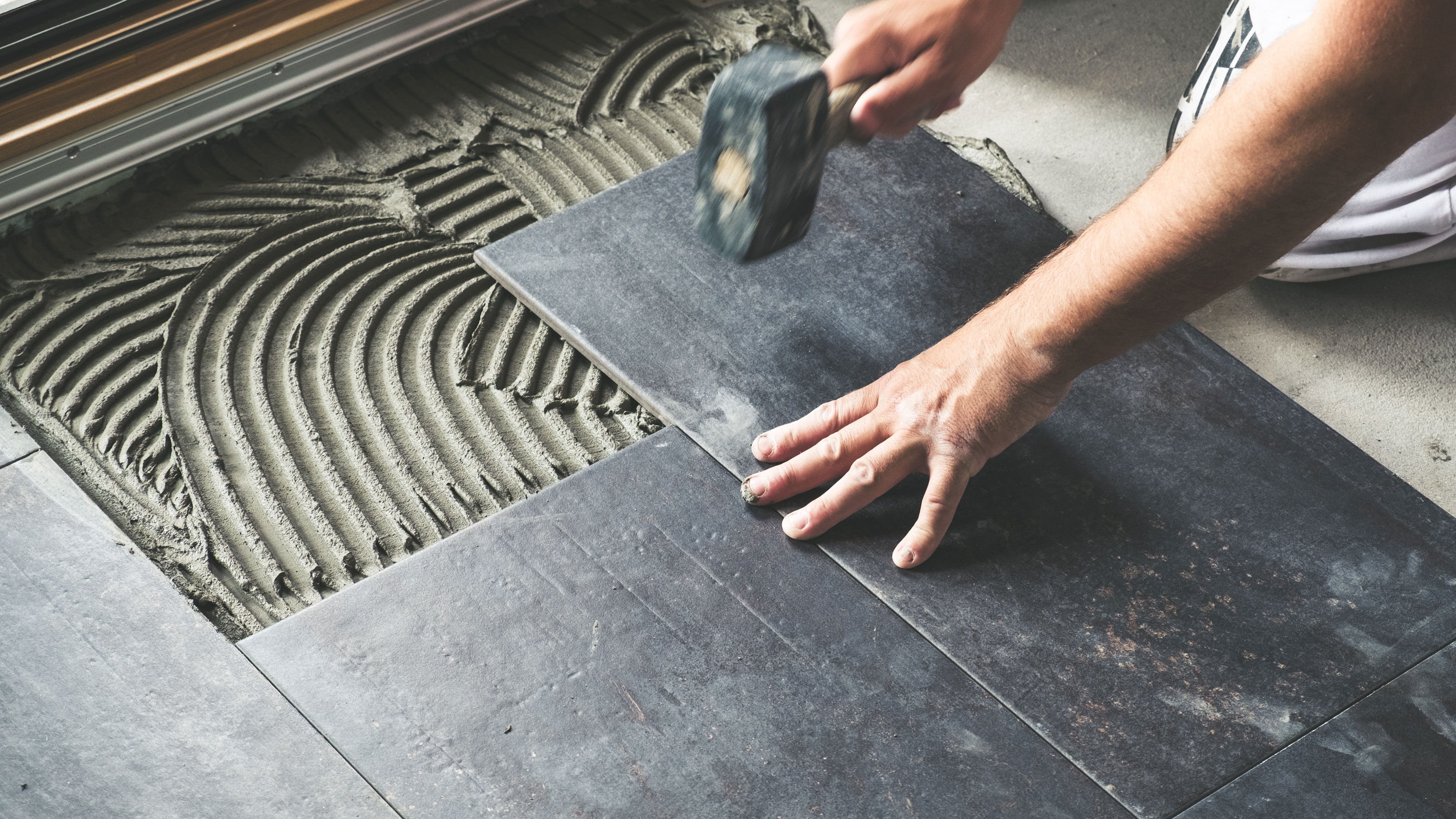Tiling a floor tips, techniques and questions answered by an expert
If you are thinking of tiling a floor there’s plenty that every DIYer needs to know. Here you’ll find expert tips and advice for a pro looking finish

- What should I put down before tiling a floor?
- Where do you start when tiling a floor?
- How much adhesive will I need to tile a floor?
- What gap do you leave between tiles?
- Do you tile right up to a wall or leave a gap?
- What happens if I grout too soon?
- Do you plumb or tile first?
- What is the difference between wall and floor tiles?
Tiling a floor is a task that DIYers can tackle, especially with the help of some trade know-how. And, you won’t need a massive collection of expensive tools. Manual tile cutters – available for around £30-£40 – are an ideal choice for straight cuts. It's definitely worth investing in a few tiling tools, especially if you’ve plans for more tiling jobs.
When tiling a bathroom floor, hallway or kitchen floor, tiles are the big expense. But, doing the job yourself will save you money which you can spend on better quality tiles to make sure you get a solid, good looking, long lasting floor.
Here you'll get invaluable insight from a long-time tiler on where to start, how to prep floors and what gaps you need to ensure your tiles look like they were laid by a pro.
Tiling a floor: What you need to know
When tiling a floor there's a lot of questions that need answering. Here we give the answers to essential questions to help you get the best finish.
What should I put down before tiling a floor?
When tiling a floor it needs to be level and have a decent surface that the tiles can adhere to as Stephen Russell, Tile installer from Ashley Cross Tiling explains, “If a floor is not flat or bumpy prepare the floor with a self levelling compound if tiling onto a cement screed.”
But, if you have floorboards or boards it's slightly different. “If tiling a boarded floor, use cement board like this HardieBacker Backerboard from B&Q. Screw down every six inches and also use adhesive under the cement board.”
Russell also suggests an alternative to use, “Products such as a matting for tiles also provide a great way to provide a solid fix to a boarded floor.”
Where do you start when tiling a floor?
Before you start tiling a floor Russell says, “You need to make sure the surface is flat and any dust or debris is swept up.” Once clean, he suggests that you, “Gauge out or measure the floor to find out where the biggest cuts are to the walls to avoid unsightly small cut tiles.”
This is typically done by starting from the centre of a room and dry laying your tiles to see where they sit at the walls. If you are going to get small cut tiles at any point then you need to move the centre tile and dry lay again until you get an even match at both walls. You need to do this in both directions.
Finally when laying tiles Russell has one tip to help ensure that you get an even colour across the floor. “Mix tiles from the boxes you have to blend in any colour variations. Using one box at a time will show up when the floor has been laid.”
How much adhesive will I need to tile a floor?
Typically you will need more tile adhesive when laying floor tiles than when putting up wall tiles. Then you need to decide what type of adhesive you need, how thick it needs to be laid and what spacers are going to be used.
Larger gaps mean less adhesive. Check out our How Much Tile Adhesive Do I Need? guide to help you get it right.
What gap do you leave between tiles?
Russell explains how different tiles and trends can influence the size of the gap, “The gap (grout joint) between tiles can vary between different types of floor tiles. For example, marble tiles. because of their square edges, require a tight joint whilst terracotta tiles always look better with a wider joint.
Then again it’s a personal choice of what size joint with most floor tiling as fashion dictates.”
However, the common choice for floor tiles is 5mm, which stay uniform by using 5mm spacers like these Vitrex Floor Tile Spacers from Amazon. For tighter gaps 3mm spacers can be used, while 10mm spacers are typically used for the largest gaps.
One tip that will save money – and is good for the environment – is reusing the tile spacers rather than embedding them in the grout. Place the spacers so one of the points is pointing out. When the tile adhesive is dry you can pull out and reuse.

Do you tile right up to a wall or leave a gap?
Tiling right up to a wall is not advisable especially if it's a stud or partition wall as Russell reveals, “It’s a good idea to leave a small gap to the wall when laying floor tiles. When walls are timber framed there is movement during different times of the year and a gap is insurance against tiles lifting because of pressure. The tiles are typically covered by skirting boards so the gap will not be seen.”
What happens if I grout too soon?
As a general rule you shouldn’t think about grouting floor tiles on the same day as you tile. You need to allow the title adhesive to dry properly before you think about grouting. Typically this will take around 4-6 hours depending on conditions. Ideally you want to leave tile adhesive for 24 hours before adding grout.
Three issues that can happen if you grout too soon
Weak bond to surface
Adding grout when the adhesive is still wet seals in the moisture in the adhesive, not allowing it to dry properly. This means it won’t be as strong and tiles can lift off the floor and move.
Mould and discolouration
Trapping in the moisture of the tile adhesive means that it can remain wet for a lot longer than it should. This can lead to mould developing underneath the tile which can weaken the adhesive and cause grout discolouration. The best grout cleaners can help keep grout sparkling, but if you make sure your adhesive is dry and you won’t need to clean too often.
Need to start again
If you do grout too soon and encounter the issues above you will need to remove the grout and lift off the tiles and start again, including regrouting the tiles. This is not only time consuming but will be expensive, so make sure to leave adhesive to dry as recommended.
Do you plumb or tile first?
This depends on what plumbing needs to be done. For example, if tiling a floor and the plumbing is coming through the walls, you can tile first. But, if the plumbing is coming through the floor then the best approach is to get the plumbing done before tiling.
What is the difference between wall and floor tiles?
Floor tiles tend to be larger and thicker as they have to withstand much more weight and use than wall tiles. While wall tiles tend to be thinner, smaller and lighter as they don’t encounter any footfall, so don't need to be as strong. But, there is plenty of crossover with some wall tiles suitable for floors and floor tiles for walls.
The material is also a factor with porcelain a popular choice for floors while wall tiles are often ceramic. Porcelain tiles are fired at a higher temperature which create a stronger material ideal for floors. Check the difference in our porcelain vs ceramic tiles guide.
Also consider the finish, a shiny slippery finish is obviously no good for a floor, especially when wet. Check the slip resistance of a tile if you can and look at any reviews to help judge how good a tile is for a specific type of floor.
Get the Homebuilding & Renovating Newsletter
Bring your dream home to life with expert advice, how to guides and design inspiration. Sign up for our newsletter and get two free tickets to a Homebuilding & Renovating Show near you.
Steve Jenkins is a freelance content creator with over two decades of experience working in digital and print and was previously the DIY content editor for Homebuilding & Renovating.
He is a keen DIYer with over 20 years of experience in transforming and renovating the many homes he has lived in. He specialises in painting and decorating, but has a wide range of skills gleaned from working in the building trade for around 10 years and spending time at night school learning how to plaster and plumb.
He has fitted kitchens, tiled bathrooms and kitchens, laid many floors, built partition walls, plastered walls, plumbed in bathrooms, worked on loft conversions and much more. And when he's not sure how to tackle a DIY project he has a wide network of friends – including plumbers, gas engineers, tilers, carpenters, painters and decorators, electricians and builders – in the trade to call upon.

